Team:Cambridge/Project/VI01
From 2009.igem.org
(New page: {{Template:Cambridge2}}<!--Do not remove the first and last lines in this page!--> = Violacein Pigments = <!-- This is for the top grey / blue links bar !--> {{Template:Cambridgetemplate...) |
(→Background) |
||
| Line 18: | Line 18: | ||
[[Image:Violacein pigment production.jpg]] | [[Image:Violacein pigment production.jpg]] | ||
| - | From | + | From August et al (2000). |
| - | The vioE is used in the step just after the vioB for the 1-2 shift of the indole ring. | + | The vioE is used in the step just after the vioB for the 1-2 shift of the indole ring. Sánchez et. al (2006) |
| - | Further, as module 5 is Aqua, expressing the genes under different promoters will allow us to produce at least two different colours. | + | Further, as module 5 is Aqua, expressing the genes under different promoters will allow us to produce at least two different colours. Sanchez suggests that removing vioD can produce a dark blue, while removing vio C produces a dark green. Our actual results showed that the ABDE construct produced a dark green pigment while the ABCE produced light green. |
'''Vio Operon''' | '''Vio Operon''' | ||
| Line 31: | Line 31: | ||
*vio gene cluster complete cds AB032799 and AF172851. | *vio gene cluster complete cds AB032799 and AF172851. | ||
| - | + | We aim to successfully express violacein in ''E. coli,'' to synthesize the violacein operon as a biobrick, and to manipulate the operon to produce the other two pigments. | |
| - | |||
| - | |||
| - | |||
| - | |||
| - | |||
| - | |||
| - | |||
{{Template:CambridgeBottom}} | {{Template:CambridgeBottom}} | ||
Revision as of 22:06, 21 October 2009
Categories :
Project :
-
Overview
Sensitivity Tuner
--- Characterisation
--- Modelling
Colour Generators
--- Carotenoids (Orange/Red)
--- Melanin (Brown)
--- Violacein (Purple/Green)
The Future
Safety
Notebook :
Team Logistics :
Violacein Pigments
Background
Violacein Biosynthesis
The Violacein pigment is produced from L-tryptophan via a pathway involving five enzymes, VioA-E. This forms a purple colour which remains within the individual cell colonies. This synthesis pathway is shown below:
From August et al (2000).
The vioE is used in the step just after the vioB for the 1-2 shift of the indole ring. Sánchez et. al (2006)
Further, as module 5 is Aqua, expressing the genes under different promoters will allow us to produce at least two different colours. Sanchez suggests that removing vioD can produce a dark blue, while removing vio C produces a dark green. Our actual results showed that the ABDE construct produced a dark green pigment while the ABCE produced light green.
Vio Operon
Our VioA-E genes are from Chromobacterium voilaceum ATCC 12472 in the pPSX vio+ plasmid. This was kindly provided by John Pemberton; Department of Microbiology and parasitology, University of Queensland, Brisbane, Australia. (Sarovich & Pemberton (2007) Plasmid 57:306-313)
- pPSX sequence ID FJ422118
- vio gene cluster complete cds AB032799 and AF172851.
We aim to successfully express violacein in E. coli, to synthesize the violacein operon as a biobrick, and to manipulate the operon to produce the other two pigments.
 "
"
